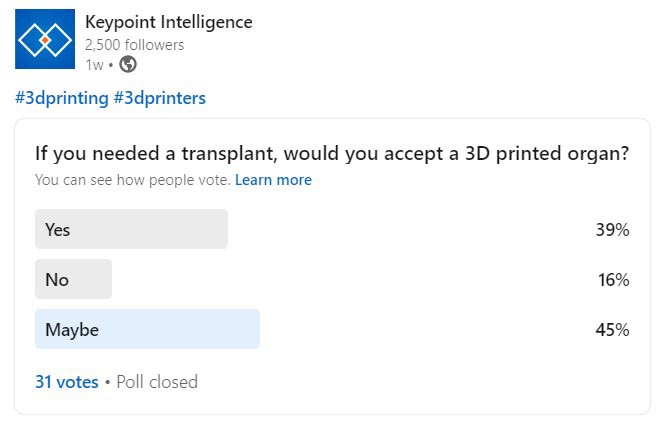- Demand outstrips supply when it comes to organ transplants, and 3D printing might help close the gap in supply by providing an alternative solution.
- During a recent Keypoint Intelligence poll, only 16% of respondents reported that they would outright refuse a 3D-printed organ if they were in need of a transplant.
- Although not yet commercially available, clinical trials for prosthetic bio-printed eyes are promising and represent a huge leap for the combining of 3D printing and medical prosthetics.
By Mark Davis
Introduction
3D printing, also known as additive manufacturing, has revolutionized a variety of industries in the recent past. The healthcare industry is certainly no exception—the 3D printing of human organs (or “bio-printing”) is already changing the way we handle transplant needs. In fact, it is quite likely that bio-printing will become commonplace within the next decade.
Demand Surpasses Supply
It’s no secret that demand outstrips supply when it comes to organ transplants, and 3D printing might help close the gap in supply by providing an alternative solution. In the United States alone, there are over 100,000 men, women, and children on the National Organ Transplant waiting list. Living donors provide an average of 6,000 organs a year, while about 8,000 deceased donors provide roughly four organs each per year. Unfortunately, 17 people die each day waiting for an organ transplant, and another person is added to the transplant list every nine minutes. The demand for kidney transplants is particularly high.
What Would You Do?
Given the shortage and general unsustainability of natural specimens, bio-printing might help meet the urgent need for organ transplants. According to Martine Rothblatt of United Therapeutics, “There’s no practical reason why those who need an organ shouldn’t get one.”
So the question is, would you accept a 3D-printed organ if you needed a transplant? Keypoint Intelligence posed this very question to its readership during a recent poll, and the results were quite compelling. Although the highest percentage of respondents said that they might, only 16% reported that they would outright refuse a 3D-printed organ. Meanwhile, nearly 40% of respondents stated that they would accept a bio-printed organ.
Figure 1. Acceptance of 3D-Printed Organs

Bio-Printing in Action
So how does 3D organ printing actually work? A needle biopsy of the required organ is taken so that the necessary cell tissue can be extracted. Doctors are then able to tease the relevant cells apart from the tissue to grow the organ outside of the body. The growing phase takes place in a sterile incubator where doctors monitor progress and feed the organ. During this phase, a glue-like substance is added to bind the cells together. Usually made of collagen, the glue is non-toxic, biodegradable, and biocompatible to avoid a negative immune response once the organ has been implanted.
The “bio-ink”—which consists of the cells and binding ink from the incubator—is then loaded into the 3D printing chamber. X-rays and scans of the intended patient enable personalized properties to be incorporated onto the printed organ. The printing process usually takes a few hours to complete, depending on the fineness of the resolution and the number of printheads in use. The entire process can be completed in as little as 4–6 weeks. Of course, the real test comes in the form of ensuring that the bio-printed organ functions as expected once implanted in the body. This includes making sure that the cells fuse the organ in the body once the glue itself has decayed.
In 2021, a British man became the first patient in the world to be fitted with a 3D-printed eye. The prosthetic, which was fitted at the Moorfield Eye Hospital in London, is fully digital and more realistic than other alternatives with greater definition and depth in the pupil. The new eye can be developed in half the time it takes to develop other alternatives, and it can be customized to better match the recipient’s other eye. Although not yet commercially available, clinical trials for prosthetic bio-printed eyes are promising and represent a huge leap for the combining of 3D printing and medical prosthetics.
The Bottom Line
Although many in the healthcare industry are conservative in their estimates for when medicine can fully transition to bio-printed organs, their continued development—and initial success—is a great indication of optimism that they may become a viable alternative for transplant patients. Accessible and cost-effective, they can also help to ease the distress and pressure placed on the body from other related procedures, such as dialysis.
3D printing capabilities are already significantly altering the way we mass-produce designs that were previously impossible to create. The fusion of medicine and 3D printing is yet another marvel that will make solutions more readily available and ultimately save lives. It will be fascinating to see how this technology establishes itself in the coming decade. With ongoing advancements in 3D printing, it’s entirely possible that even more people will become open to the idea of receiving a 3D-printed organ.
As a Research Associate for Keypoint Intelligence’s Content & Publishing Group, Mark Davis is responsible for producing Lab Test Reports, blogs, and other deliverables for the company’s public site. He previously held marketing positions in the automotive, education technology, and dental insurance sectors.














